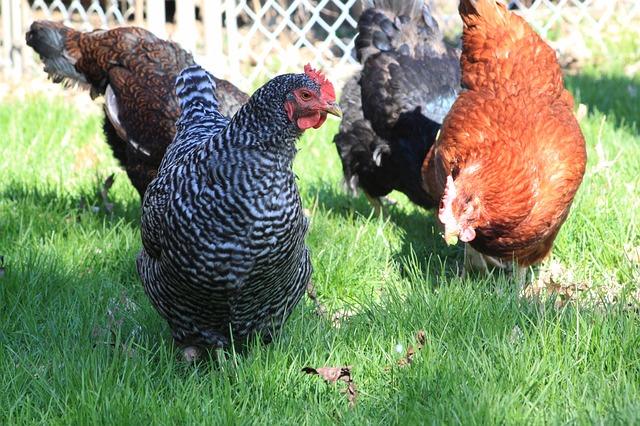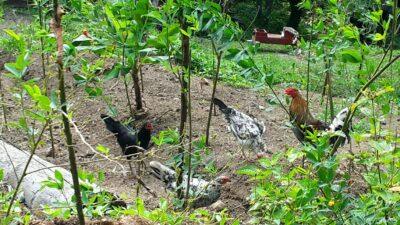When my husband, 2-year-old son and I emptied our apartment and moved off grid in the Caribbean, seven chickens were the last residents we were expecting.
New to the off-grid experience, we were eager to learn nature’s way of doing things. The two roosters and five hens were our first lesson. Our new friends came by the cabin at the crack of dawn every morning, calling or walking up the cabin step to announce their arrival, when breakfast was late.
There is how we got them laying in a coop:
1. Build trust.
We began by feeding them dry coconut from the property and food scraps every morning. The chickens like dry coconut. But at first, they ran away when we got close. We stuck to the routine of putting their food out and sitting a short distance away to observe them. Sometimes, I would crouch when feeding them to show I didn’t mean any harm. I soon noticed this made the chickens more comfortable, and they began to come closer. We noticed that they were creatures of habit. The chickens made the same rounds around the property every day and slept in the same tree. Within three weeks of feeding them, they allowed us to get close and walk around them while feeding.
2. Get them interested.
We built them a coop but didn’t want to lock them in it for two weeks as was recommended. Instead, we wanted the transition to be as natural as possible. Since the chickens are accustomed to roaming freely and sleeping in trees, we thought it would be stressful for them to be put in a new place. So to get them interested in the coop, I would leave a trail of breadcrumbs leading from our yard to the coop at the back. Since they are creatures of habit, we thought changing their feeding location would take a while before they adjusted. But they caught on to the new location within two days. The coop had seven nesting boxes and a small ladder to facilitate them going up and down easily. They would still fly up to their boxes and jump back down. I would put the feed on the step leading to the nest boxes to spark their curiosity.
All The Answers To Every Chicken Question And Quandary …
Three days after the coop was built, we had our first egg. I was ecstatic: “My hen has laid its first egg!” I have also read that putting fake eggs in the nest boxes can encourage the laying process. Another technique I use is leading them to the coop when they are ready to lay. Recently I have been able to distinguish the clerking sound the hens make when ready to lay. I would walk up to her slowly, show her an egg, and then walk away slowly so she would follow me — after which I would put the egg in the nest box where I want her to lay, and she would enter. I have been able to change a hen’s nesting location using this method — especially for those who keep laying outside.
3. Be observant.
Studying the hierarchy and group dynamics enabled us to see which hens would be laying fertile eggs (mating regularly) compared to the newer hens who were picked on while feeding. When we noticed some hens got less food, we would put food separate from the group for them. Soon, these hens began to lay, as well. Watching them closely, we were able to get a feel for their individual personalities. We got so good that when my husband found eggs inside the cabin, we knew exactly who it was – Sally, the adventurous and strong-willed hen. By paying attention to the chickens, I also realized that they didn’t like newspapers under the dried leaves to the bottom of their nest boxes. The hens would scratch it out and then go into one with only the dried leaves. As a result, I kept only dried leaves in nest boxes.
Our chickens lay once a day, and sometimes lay in each other’s nest boxes. Chickens have their own language, and when given it enough attention you learn what each clerking sound means. The high pitch rapid clerking sound is usually made when they feel threatened. We did research to find the chicken predators in our area. Our dog gives the mongoose a run for their money, but we have to tie the dog while the chickens are roaming. It’s a tough process trying to get the dog to stop running after the chickens.
Get Diatomaceous Earth Here! It’s The Time-Tested Way To Get Rid Of Bugs
When the hens want to mate, they make a low pitch sound to get the rooster’s attention. If you aren’t close enough, you may miss it. We always thought the hens didn’t give consent, but they do very subtly. Because our chickens have roosters, they roam more freely as he protects and feeds them.
4. Know their routine and meet their needs.
I noticed that our garden beds were the hangout spot during the day, so we had to train them to keep out of the garden. To assist them, we made a garden bed just for them and kept chasing them onto it every time they scratched the garden. As the plants grew taller, they were less of a problem and more like little helpers than they were when the plants were younger. They ate the weeds and bugs between the plants. I gave them fresh water on a morning in coconut shells. (They seemed suspicious of my plastic containers.)
Raising my chickens has been an amazing experience — from marveling at the bright orange color yoke to the dramatic nutrient difference between free-range chicken eggs and store-bought eggs. Allowing the chickens to live like chickens — eating worms, grass and insects — and getting plenty of fresh air and exercise is the reason they are healthier than supermarket eggs.
If you live off grid, then owning chickens has to be part of the experience. Apart from having your free-range eggs, you can put wood chips on the floor of their coop and rack it out for your garden manure. You’ll never miss television with chickens around. But the only way to really enjoy rearing chickens is to mimic nature. Let them sleep in the trees if your property is fenced. Let chickens be chickens; they know how to do it better than we do.
What advice would you add on raising free-range chickens? Share your tips in the section below:
Harness The Power Of Nature’s Most Remarkable Healer: Vinegar
 Off The Grid News Better Ideas For Off The Grid Living
Off The Grid News Better Ideas For Off The Grid Living








